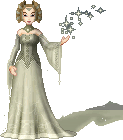| Making patterns is so easy & so much fun, I feel bad keeping the "secret" to myself! You'll soon see why I have so many patterns available for download... | ||
| 1. Open a new image, about 200x200 pixel to give yourself some room to work with. | 2. Create a new layer. Name it whatever you like - I tend to name them the number of the pattern e.g. 001 or 027. | 3. Select your foreground colour. I tend to use black, but you can use any colour you like. |
 |
 |
 |
| 4. Using the Paintbrush tool with an Opacity of 100% & Size of 1, draw a scribble. Yes, you heard me - a scribble! | 5. Press CTRL+C on your keyboard to copy the scribble. Press CTRL+E to paste it as a new selection. Press CTRL+M to mirror it. | 6. Click on the Selection tool. As you move your cursor over the selection, the 4 pointed "move" cursor should be displayed. Click on your selection & drag it into a position where it looks pretty. For best results, I try to keep with width of the shape an uneven number of digits. |
 |
 |
 |
| 7. When you are happy with the placement/shape, press CTRL+D to drop the selection. | 8. Press CTRL+C to copy the new shape. Press CTRL+E to paste it as a new selection. Press CTRL+I to flip it. As before, click on the Selection tool & move it into position. |
9. If you're happy with the shape, you can leave it like that. Otherwise, click on CTRL+C to copy, CTRL+E to paste then CTRL+R to rotate. Choose to rotate the image 90 degrees, either left or right. |
 |
 |
 |
| 10. Position the selection as required. Press CTRL+D to drop the selection once your happy. | 11. Press CTRL+C to copy the new shape. Press CTRL+E to paste it as a new selection. Move it into position on the canvas, relative to the original shape. When you're just starting, you'll probably find it easier to place the image vertically or horizontally next to the original, rather than along the diagonal. | 12. Press CTRL+C to copy your 2 shapes. Press CTRL+E to paste it as a new selection. Move it into position, making sure one of the patterns is over one of the existing ones, to keep the spacing/angle between them the same. Press CTRL+D to drop the selection. |
 |
 |
 |
| 13. Press CTRL+C to copy all 3 patterns. Press CTRL+E to paste as a new selection. Press CTRL+M to mirror. Move the selection into position, again using one of the exisiting shapes as reference. Press CTRL+D to drop the selection once you're happy with the placement. | 14. Now's the easy bit. Press CTRL+C to copy. Press CTRL+E to paste the new selection & move into position. Continue the process of pressing CTRL+E & moving the selection until the your are happy that you can see the repeating of the pattern clearly. | 15. Now we need to make this into a tileable graphic (unless you are happy to carry on pasting the pattern as much as you need it, in which case you can end off here). If you try to Flood Fill an area with the pattern at the moment, you'll clearly see it doesn't tile! |
 |
 |
 |
| 16. Zoom in on your image. Look closely to see where the pattern repeats. I have highlighted this in green in the above image. There will be lots of points you can take it from, I usually just try to find an easy point of reference to focus on. |
17. I have focused on the corner of one of the shapes & drawn the green box between the points where this point appears on the other shapes. | 18. Using the Shape selection tool, set to Rectangle with no Anti-Alias or Feathering, draw a selection between the four points your have selected on you image. This does become more intuitve with practice, trust me! |
 |
 |
|
| 19. Press CTRL+C to copy the selection. Press CTRL+V to paste it as a new image. |
20. To save this as pattern for use, save it in Paint Shop Pro format for PSP8 or Window Bitmap format for PSP7 within the Patterns folder (this varies depending on your version of Paint Shop Pro, but it's usually something like C:\Program Files\JASC\Paint Shop Pro\Patterns)
Alternatively, you can just save it as a PSP file & use it as shown in my Using Patterns tutorial. |
21. Your pattern should now be available in the drop down list when you have selected "Pattern" on the Materials palette. |
 |
||
| Your pattern is complete! | ||
| << back to tutorials | ||
all content © copyright amy roberts 2001-2007 (unless otherwise stated)


